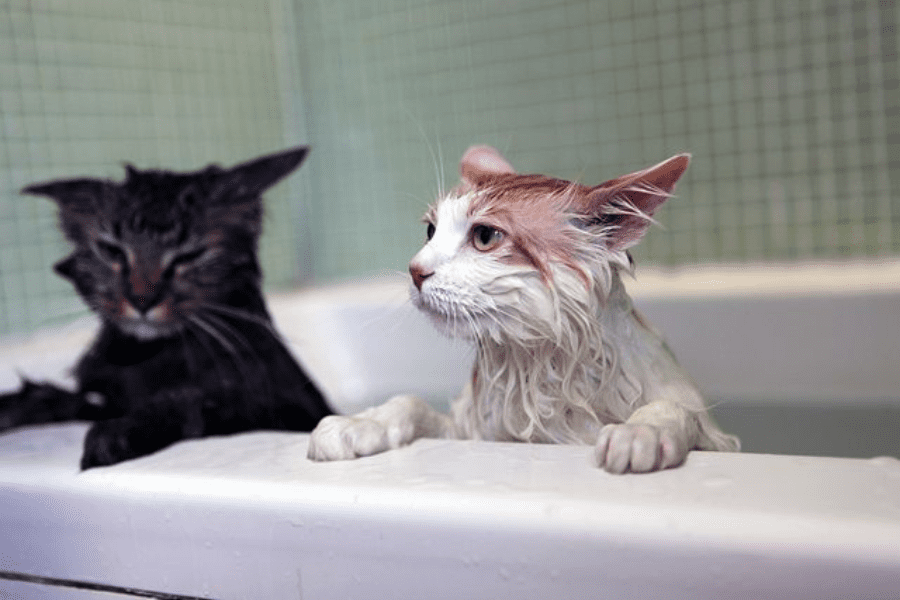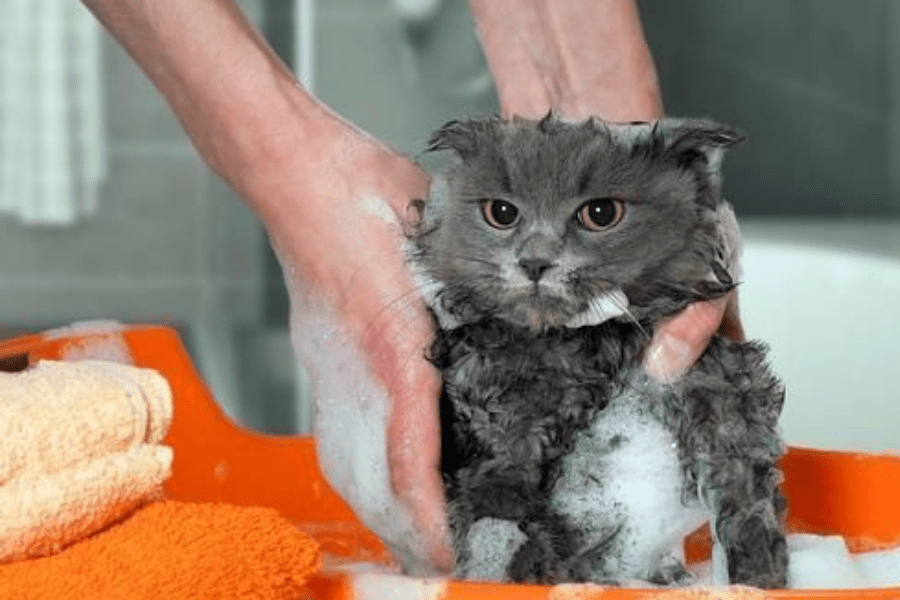Bath a cat might seem like a daunting task, but with the right approach, it can be a manageable and stress-free experience for both you and your furry friend.
Whether it’s for hygiene, medical purposes, or simply maintaining a clean coat, knowing how to bathe a cat correctly is crucial for their health and well-being.
In this comprehensive guide, we’ll walk you through everything you need to know about giving your cat a bath, from identifying when a bath is needed to ensuring your cat feels comfortable throughout the process.
How to Tell if Your Cat Needs a Bath?
Before you jump into giving your cat a bath, it’s important to recognize when it’s necessary. Cats are naturally clean animals and usually do a good job of grooming themselves. However, there are certain situations where a bath is required:
- Visible Dirt or Stains: If your cat has been rolling around outside, or if their coat appears greasy or matted, it may be time for a bath.
- Strong Odor: A foul smell coming from your cat’s fur, especially if it’s unusual or persistent, can indicate they need a wash.
- Excessive Shedding or Matting: Long-haired cats, such as Persians or Maine Coons, may need baths to help with matting or excessive shedding.
- Skin Conditions: If your cat suffers from dry skin, allergies, or flea infestations, your veterinarian may recommend a medicated bath to soothe the skin.
- Health Problems: Cats with certain medical conditions may need a bath to assist in healing or managing symptoms.
Always consult with your veterinarian if you’re unsure whether a bath is necessary or if your cat has a medical condition that requires special attention.
How Often Should You Bathe a Cat?

One of the most common questions cat owners ask is, How often should you bathe a cat? The answer depends on several factors, including your cat’s lifestyle, coat type, and health status.
- Indoor Cats: Typically, indoor cats don’t need frequent baths, especially if they are grooming themselves regularly. A bath every 2-3 months is usually sufficient, unless they get into something messy.
- Outdoor Cats: If your cat spends a lot of time outside, they may get dirtier more often and may need a bath once a month or as needed.
- Long-Haired Cats: Cats with long fur, like Persians or Ragdolls, can benefit from more frequent bathing to prevent tangles and mats. A bath every 1-2 months might be ideal.
- Cats with Skin Conditions: If your cat has a skin condition, your veterinarian may recommend more frequent baths using medicated shampoos to help soothe irritated skin or treat certain conditions.
Remember, frequent baths should be avoided unless necessary, as over-bathing can dry out their skin and coat.
Should You Bathe Indoor Cats?
Bathing an indoor cat is not usually required unless it’s for medical reasons or an occasional clean-up. However, there are some exceptions:
- Fleas: Even indoor cats can get fleas, so a bath with flea shampoo may be required.
- Hairballs: Cats with long fur are more prone to hairballs, and a bath can help reduce the frequency of these uncomfortable situations.
- Excessive Shedding: If your cat is shedding more than usual, a bath might help remove loose fur and reduce hairballs.
Generally, it’s best to bathe your indoor cat only when it’s necessary, as cats typically groom themselves well and keep their coats clean.
Cat Bath Supplies
Before you get started, make sure you have all the necessary supplies:
- Cat-Specific Shampoo: Never use human shampoo on cats, as it can irritate their skin. Look for a gentle, cat-safe shampoo that suits your cat’s needs.
- Towels: You’ll need at least two towels to dry your cat—one for blotting and another to wrap them in.
- A Cup or Gentle Showerhead: Use a gentle showerhead or a cup to pour water over your cat without startling them.
- Flea Comb: If your cat has fleas, a flea comb can help remove the parasites and eggs before or during the bath.
- Cat Brush: Brush your cat before the bath to remove tangles or mats, especially if they have long fur.
Preparing to Bathe a Cat
Preparation is key to making bath time as smooth as possible for both you and your cat. Here’s how to set up:
- Create a Calm Environment: Try to bathe your cat in a quiet, calm area where they feel safe. Avoid loud noises or distractions that might cause stress.
- Fill the Tub with Lukewarm Water: Use lukewarm water not too hot, not too cold to prevent shocking your cat. Fill the tub with just a few inches of water.
- Gather Supplies: Have all your bath supplies within easy reach. This way, you won’t have to leave your cat alone at any point.
How to Bathe a Cat: Step-By-Step

Bath a Cat
1- Wet Your Cat’s Fur Slowly
- Start by gently wetting your cat’s fur with a cup or gentle showerhead. Focus on their body, avoiding their head at first.
- Work from the back and gradually move towards the front.
2- Apply Shampoo
- Lather the cat-specific shampoo into your cat’s fur. Be gentle and avoid their face, ears, and eyes.
3- Rinse Thoroughly
- Carefully rinse the shampoo off your cat’s fur using the cup or showerhead. Make sure there’s no shampoo residue left, as it could irritate their skin.
4- Dry Your Cat
- Gently blot your cat with a soft towel to remove excess water.
- If your cat tolerates it, you can use a blow dryer on the lowest heat setting to dry their fur, but keep it at a distance to avoid scaring them.
How to Bathe a Cat That Hates Water?
Not all cats love water, and bathing a water-averse cat can be tricky. Here are some tips:
- Start Slowly: Get your cat accustomed to water by wiping them with a damp cloth before introducing them to a full bath.
- Use a Shallow Container: Use a small basin with just a few inches of water to minimize the feeling of immersion.
- Stay Calm: Cats can sense your anxiety. Stay calm and speak softly to reassure your cat throughout the process.
- Reward Afterwards: After the bath, give your cat treats and affection to create a positive association with the bath.
Do Cat Baths Help With Human Allergies?
Cat allergies are common among humans, but can bathing your cat help? Regular bathing can help reduce allergens like dander and oils on your cat’s fur, potentially offering relief to allergy sufferers. However, bathing a cat too frequently can dry out their skin, which might actually increase shedding and dander production in the long run.
If you suffer from allergies, it’s important to talk to your doctor before bathing your cat frequently, and consider using cat-specific anti-allergen shampoos that help remove dander without harming your cat’s natural oils.
Is It Cruel to Bathe Cats?
Many pet owners worry about whether bathing cats is cruel. The short answer is: no, it’s not cruel, as long as the bath is done gently and when necessary. Cats don’t enjoy baths, but they can tolerate them if done calmly and infrequently. Always avoid forcing your cat into a bath if they seem too stressed or frightened. Use positive reinforcement after the bath, such as treats or petting, to ensure your cat has a good experience.
Conclusion: Bathing Your Cat the Right Way
Bathing your cat can be a manageable and even enjoyable experience when approached correctly. Remember to only bathe your cat when necessary, and always use cat-friendly products. Whether you’re cleaning off dirt, managing shedding, or treating a skin condition, the right technique will ensure your cat stays healthy, clean, and happy.
Taking care of your cat’s grooming needs is an essential part of responsible pet ownership. By following these simple steps, you can provide your cat with the care they need while keeping the bath process as stress-free as possible.
